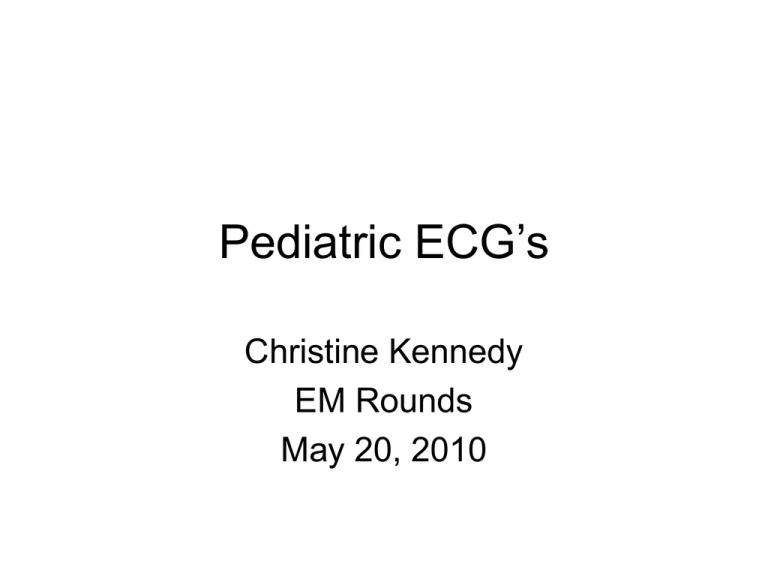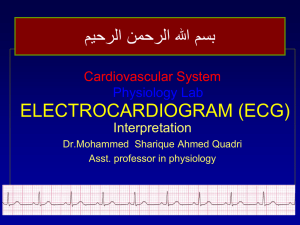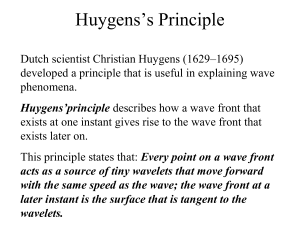Pediatric ECG`s - Calgary Emergency Medicine
advertisement

Pediatric ECG’s Christine Kennedy EM Rounds May 20, 2010 Objectives • Highlight normal findings on a Pediatric ECG – T waves – Q waves – ST segments • Identify some key abnormal findings on a Pediatric ECG (case examples) Normal Findings T waves 2 week male with ?Apparent Life Threatening Event Inverted T waves in V1 Take home point #1 T waves • Newborn (week 1): – may be either inverted or upright in V1 • Between 8 days & 8 years – Should be inverted in V1 (if not = RVH) Normal Findings Q waves 1-year-old male, asymptomatic, Mom told that child has a murmur Q waves in inferior/lat leads Take home point #2 Q waves • Q waves are normal in II, III, aVF, V5 & V6 – Absence of Q wave: suspect a VSD • Amplitude of accepted Q wave varies with age – Use lead III as reference • 6 months: up to 7 mm • 12 months: up to 5 mm • 8 years: up to 3 mm 8 year old boy referred for an irregular heart rhythm •Sinus rhythm •Varied heart rate Take home point #3 Sinus Arrhythmia • Very common in children ages 2-10 • Normal variant – Associated with increased vagal tone • Need to have normal P wave morphology and normal PR intervals* 11 year old male with chest pain Sinus rhythm, rate 60 ST elevation I, II, V2-6 Take home point #4 ST elevation • Early Repolarization – Normal Variant, common in adolescents – ST elevation <25% of T wave height – Symmetric T waves Now for some abnormal ECG’s 3-year-old girl referred with systolic murmur rsR’ in V1 Take home point #5 RSR’ • If R’>R in V1 – Suspect RVH – 25% chance of having ASD 8 week male with tachypnea Left axis deviation [30-135] RVH: S in V6 >10 [0-10], Q wave in V1 LVH: R in V6 >21 [5-21], Q wave >4mm in V6 Left axis deviation RVH: S in V6 >10 [0-10] LVH: R in V6 >21 [5-21] AVSD Take home point #6 Left Axis Deviation • LAD in first couple of months: suspect AVSD 9 year old male with loud systolic murmur at LUSB Axis +130 Pure R in V1 S in V6>4 mm Axis +130 Pure R in V1 S in V6>4 mm Pulmonary Stenosis Take home point #7 RVH • RV dominance & RAD in first couple months of life is normal – Large amplitude R waves in V1, small amplitude R waves in V5 & V6 • By 5-7 years – Expect more “adult norms” for R waves • R in V1: 0-14 • R in V6: 4-25 (4-21 by 16 years) 4-month-old infant with wheezing and cardiomegaly ST elevation in V1-3, 5, V3R, V4R Inverted T waves in V5-6 ALCAPA Anomalous Left Coronary Artery from the Pulmonary Artery Take home point #8 ST elevation • Children do get ischemia – If child is irritable with a history of recurrent wheeze/cough and ST elevation is present, consider ALCAPA Summary 1. T waves • Should be inverted in V1 between 8 days & 8 years (if not = RVH) 2. Q waves • • Normal in II, III, aVF, V5 & V6 Absence of Q wave: suspect a VSD 3. Sinus Arrhythmia • • Very common in children Look for normal P wave morphology & PR interval Summary 4. Early Repolarization • Normal Variant, common in adolescents • ST elevation <25% of T wave height 5. RSR’ • If R’>R in V1, suspect RVH – 25% chance of having ASD 6. Left axis deviation • If present in first couple of months: suspect AVSD Summary 7. RV dominance & RAD • Normal in first couple months of life 8. Children do get ischemia • If child is irritable with a history of recurrent wheeze/cough and ST elevation is present, consider ALCAPA Table of LVH/RVH criteria Table of Normals References • Pediatric ECG Interpretation-An Illustrative Guide. B.J. Deal, C.L. Johnsrude, S.H. Buck. • The Pediatric ECG. G.Q. Sharieff, S.O. Rao. Emerg Med Clin N Am 24 (2006). 195-208. Other Pearls • PR interval short at birth (0.08-0.15), increases with increasing muscle mass • QRS shorter – Abnormal If >0.08 in children <8 years • LVH – LV strain in V5&V6 (flipped T’s), mature precordial R wave progression in newborn • Sinus tachycardia – When febrile, expect HR to increase by 10 for every degree elevation in temperature







